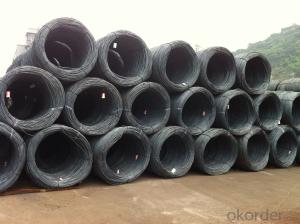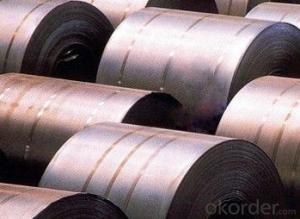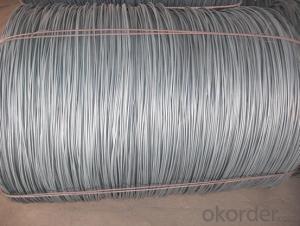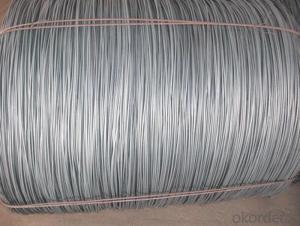Hot rolled wire rod
- Loading Port:
- China Main Port
- Payment Terms:
- TT OR LC
- Min Order Qty:
- -
- Supply Capability:
- -
OKorder Service Pledge
OKorder Financial Service
You Might Also Like
Also called wire rod, steel wire rod (s), small diameter steel usually refers to adisk. Wire diameters in the range 5-19 mm (usually 6-9 mm), the lower limit is the minimum size of hot rolled steel sections. The diameter of the round steelwire rod is relatively small, commodity form is rolled into plate supply, at the site of common have diameters of 6, 8, 10, 12 mm, low carbon steel are,generally not used for main reinforcement of reinforced concrete structure,much used for steel sleeve, and a small diameter for the brick reinforcedmasonry structure in the "". Many varieties of wire rod. Low carbon steel wire rod steel wire rod in the commonly known as cords, in high carbon steel wire,hard line. Blank wire rod are used mainly for drawing, but also can be directlyused as building materials and processed into mechanical parts. Stainless steel wire rod used in the manufacture of stainless steel wire, stainless steelspring wire, stainless steel wire and stainless steel wire rope forging steel wire.With the advances in production technology, has been the emergence of a square,
Hexagon, fan and other special-shaped section wire rod; the upper limit of the diameter has been expanded to 38 mm; disc weight from the original 40-60 kghas increased to 3000 kg. Due to the development of new heat treatment process after rolling, the iron oxide scale on wire rod surface obviouslythinning, organizational performance is greatly improved. Wire rod needs to use the bar straightening machine straightening feeding before use, but alsothe removal of oxides in the machine, but also in the bending tensilerepeatedly, a certain increase strength. Small site without straightening machine, windlass straightened wire rod used, if it is a direct pull is not desirable, easy to produce plastic deformation is too large, should end with ahammer to control the tension pulley.
Commonly used wire line production.
A, through the step by step the billet heating furnace heated to above 1100 degrees Celsius;
Two, heating the billet, after high pressure water descaling;
Three, into the roughing mill rolling, roughing mill for the strip plant;
Four, after roughing rolled piece into the water for cooling, in order to control its internal microstructure;
Five, leave water cooling period after entering the mill and finishing mill for further rolling;
Sixth, after finishing the shape of rolled piece formed by spinning machine spit out volume;
Seven, volume of wire forward cooled in the air cooling section;
Eight, at the end of the air cooling section, wire rod by coil unit into drum shape;
After nine, with drum shape of baling wire into the baling machine;
Ten, into the shipping department.
use
Wire is mainly used as the reinforcement of reinforced concrete and welding structure or reprocessed raw material (such as drawing, nail, etc.). According to the steel distribution directory, mild steel wire including ordinary hot-rolled wire rod, welding rod, blasting line with wire rod, conditioning threaded rod, high quality wire rod. USES a wide range of mild steel wire rod is mainly ordinary hot-rolled wire rod, also known as the common wire, it is composed of Q195, Q215, Q235 plain carbon steel hot rolling and nominal diameter 5.5 14.0 mm, rolling into each coil weight in 100-200 kg, now with no twist on the high speed wire mill rolling and control cooling after rolling, a diameter of 5.5 22.0 mm the grail weighing up to 2500 kg. Ordinary wire is mainly used for construction, wire drawing, packaging, welding rod and produce bolts, nuts, rivets, etc. High quality wire, only supply high quality carbon structural steel hot rolled wire rod. Such as ML08AL, 08 f, 10 b21, 35 mn, mn, 65, 75, 50 mn, etc. Used as the material of steel wire and other metal products and other structures, and other high-quality steel rolling of wire rod. More than 8 mm on high quality material, 8 mm below listed in metal products.
The dosage of wire rod is one of the large steel varieties. After rolling can be directly used in the reinforcement of reinforced concrete and the welding structure, and also can be used by the reprocessing. For example, by drawing into all kinds of wire, which are then rewinded into wire and twist wire rope, woven winding and heat treatment as a spring; The heat into the rivet and cold forging, cold forging and rolling as bolts, screws, etc.; Through cutting into heat treatment machine parts or tools.
Is the world's largest producer of wire rod in China, the annual output more than a third of total world production, wire is also China's second largest steel products, in the proportion of domestic steel production has been higher, 2007 domestic wire rod production accounts for 14.2% of the proportion of the total steel production in China. In recent years, domestic wire rod production base and the domestic crude steel production growth speed, almost remain at around 20%, growth slowed in 2007, down to 13.8%, the total is relatively nearly doubled in 2003. From import and export of wire rod, wire for a long time has been a main steel products export in our country, also is our country has maintained a net export status of steel varieties, especially the special rapid export growth in recent years. In 2007 China's exports of 6.238 million tons wire, year-on-year increase of 684000 tons, up 12.3%; Import 614000 tons, 91000 tons less than a year. From domestic consumption, wire wire application in the field of architecture is more, since 2000, driven by the domestic investment demand situation, domestic wire rod consumption has been maintained a fast growth.
Wire with deeper purpose: in many areas is one of the most widely in the IT industry.
Non-ferrous wire is widely used now.
- Q:What are the different mechanical tests conducted on steel wire rod?
- There are several mechanical tests conducted on steel wire rods to evaluate their quality and performance. These tests include tensile strength testing, which measures the maximum load the wire can withstand before breaking; yield strength testing, which determines the point at which the wire starts to deform permanently under stress; elongation testing, which measures the wire's ability to stretch before breaking; and hardness testing, which evaluates the wire's resistance to indentation or scratching. Additionally, other tests such as impact testing and fatigue testing may also be performed to assess the wire's durability and ability to withstand sudden or repetitive loads.
- Q:What are the common production processes for silicon-coated steel wire rod?
- The common production processes for silicon-coated steel wire rod include wire drawing, heat treatment, silicon coating, and coiling.
- Q:What are the different tolerances for steel wire rods?
- The tolerances for steel wire rods can vary depending on the specific requirements and industry standards. Common tolerances include diameter tolerances, straightness tolerances, and surface quality tolerances. These tolerances ensure that the steel wire rods meet the desired specifications and can be used effectively in various applications such as construction, automotive, and manufacturing.
- Q:What are the different surface defects that can affect the fatigue strength of steel wire rod?
- Some of the different surface defects that can affect the fatigue strength of steel wire rod include scratches, pits, cracks, and decarburization. These defects can act as stress concentrators, leading to an increased likelihood of fatigue failure.
- Q:How is steel wire rod used in the production of wire for medical devices?
- Steel wire rod is an essential raw material in the production of wire for medical devices. It serves as the starting point for manufacturing wire that meets the specific requirements of medical applications. The steel wire rod is processed through various stages such as drawing, annealing, and coating to achieve the desired diameter, strength, and surface finish. This wire is then used in the fabrication of medical devices like surgical instruments, catheters, and orthopedic implants, ensuring they possess the necessary strength, flexibility, and biocompatibility required for medical use.
- Q:How are steel wire rods used in the manufacturing of welding wires?
- Welding wires are manufactured from steel wire rods, which are essential components in the manufacturing process. Typically made of carbon steel, these wire rods undergo various manufacturing processes to transform them into welding wires. To begin with, the steel wire rods are cleaned to eliminate impurities and contaminants. This step ensures that the resulting welding wires meet high-quality standards and are suitable for welding applications. The cleaning process may involve techniques such as acid pickling or mechanical descaling. Once cleaned, the wire rods are drawn through a series of dies to reduce their diameter to the desired size. This drawing process elongates and thins the rods by pulling them through progressively smaller dies. The result is a more uniform wire diameter, which is crucial for precise welding applications. After achieving the desired diameter, the wire rods may undergo additional treatments depending on their intended use. For instance, heat treatment processes like annealing can be applied to enhance the wires' mechanical properties and reduce internal stresses. Next, the wire rods are typically coated with materials like copper to improve their electrical conductivity and provide corrosion resistance. This coating also enhances the weldability of the wires. Finally, the coated wire rods are spooled onto reels or coils to be used in various welding processes. These welding wires are then supplied to industries and professionals engaged in welding applications, such as construction, automotive, or manufacturing. In conclusion, the manufacturing of welding wires involves a series of processes, including cleaning, drawing, heat treatment, coating, and spooling. These wires play a crucial role in welding applications, offering a reliable and efficient means of joining metals together.
- Q:How is steel wire rod used in the production of wire mesh sieves?
- Steel wire rod is used in the production of wire mesh sieves as it serves as the primary material for creating the mesh structure. The wire rod is first drawn through a series of dies to reduce its diameter and increase its length, resulting in a long, thin wire. This wire is then woven or welded together to form the mesh pattern, which is subsequently stretched and shaped into the desired sieve shape. The strength and durability of the steel wire rod ensure that the wire mesh sieves can withstand rigorous usage, making them suitable for various industrial applications such as filtration and particle size analysis.
- Q:What are the main competitors of steel wire rod?
- Some of the main competitors of steel wire rod include aluminum wire rod, copper wire rod, and stainless steel wire rod.
- Q:How is steel wire rod used in the manufacturing of wire forms for filtration systems?
- Steel wire rod is an essential component in the manufacturing of wire forms for filtration systems. The wire rod serves as the primary raw material for producing wires of various diameters and strengths, which are then shaped into specific forms used in filtration systems. To begin the manufacturing process, the steel wire rod is first carefully selected based on its composition, mechanical properties, and desired characteristics. This ensures that the wire rod is suitable for the specific filtration system requirements, such as resistance to corrosion, high tensile strength, and durability. Once the appropriate steel wire rod is chosen, it undergoes a series of manufacturing steps to transform it into wire forms for filtration systems. The wire rod is first cleaned and descaled to remove any impurities or surface contaminants that may affect its performance. It is then heated to a specific temperature to make it more malleable and easier to shape. The heated wire rod is then passed through a series of dies or molds, which give it the desired shape and dimensions for the wire forms used in filtration systems. The wire may be drawn through multiple dies to achieve the desired diameter and strength required for effective filtration. After shaping, the wire forms go through additional processes like annealing, which involves heating and slowly cooling the wire to relieve any stresses and improve its ductility. This step ensures that the wire forms can withstand the demands of filtration systems, such as high pressure or constant use. Once the wire forms are manufactured, they can be further processed or assembled into complete filtration systems. For example, the wire forms may be welded or joined together to create mesh screens or filter elements, which are then integrated into the overall filtration system design. Overall, steel wire rod plays a crucial role in the manufacturing of wire forms for filtration systems. Its versatility, strength, and ability to be shaped and transformed into various forms make it an ideal material for producing wires that meet the specific requirements of filtration systems. Whether it's for removing contaminants from liquids or gases, steel wire rod ensures the durability and effectiveness of filtration systems in a wide range of industries.
- Q:What are the different types of steel wire rod surface defect prevention and mitigation measures?
- There are various methods to prevent and mitigate surface defects on steel wire rods. Some common measures include implementing proper handling and storage practices, ensuring adequate lubrication during the manufacturing process, utilizing effective cooling techniques, employing surface treatment methods like pickling or phosphating, conducting regular inspections and quality control checks, and implementing corrective actions promptly to address any identified defects. Additionally, proper maintenance of equipment, adherence to industry standards and guidelines, and continuous training and education of personnel are crucial in preventing and mitigating surface defects on steel wire rods.
1. Manufacturer Overview |
|
|---|---|
| Location | |
| Year Established | |
| Annual Output Value | |
| Main Markets | |
| Company Certifications | |
2. Manufacturer Certificates |
|
|---|---|
| a) Certification Name | |
| Range | |
| Reference | |
| Validity Period | |
3. Manufacturer Capability |
|
|---|---|
| a)Trade Capacity | |
| Nearest Port | |
| Export Percentage | |
| No.of Employees in Trade Department | |
| Language Spoken: | |
| b)Factory Information | |
| Factory Size: | |
| No. of Production Lines | |
| Contract Manufacturing | |
| Product Price Range | |
Send your message to us
Hot rolled wire rod
- Loading Port:
- China Main Port
- Payment Terms:
- TT OR LC
- Min Order Qty:
- -
- Supply Capability:
- -
OKorder Service Pledge
OKorder Financial Service
Similar products
New products
Hot products
Hot Searches
Related keywords





























